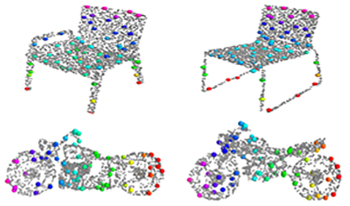
Sparse representation is the key part of shape registration, compression, and regeneration. Most existing models generate sparse representation by detecting salient points directly from input point clouds, but they are susceptible to noise, deformations, and outliers. The authors propose a novel alternative solution that combines global distribution probabilities and local contextual features to learn semantic structural consistency and adaptively generate sparse structural representation for arbitrary 3D point clouds. First, they construct a 3D variational auto-encoder network to learn an optimal latent space aligned with multiple anisotropic Gaussian mixture models (GMMs). Then, they combine GMM parameters with contextual properties to construct enhanced point features that effectively resist noise and geometric deformations, better revealing underlying semantic structural consistency. Second, they design a weight scoring unit that computes a contribution matrix to the semantic structure and adaptively generates sparse structural points. Finally, the authors enforce semantic correspondence and structural consistency to ensure that the generated structural points have stronger discriminative ability in both feature and distribution domains. Extensive experiments on shape benchmarks have shown that the proposed network outperforms state-of-the-art methods, with lower costs and more significant performance in shape segmentation and classification.
Li Han, Feng Dou, Xueying Chen, Yuping Zhang, Chenyang Fu, Xiaocong Wei, "Sparse Structural Representation Learning for 3D Point Clouds" in Journal of Imaging Science and Technology, 2025, pp 1 - 11, https://doi.org/10.2352/J.ImagingSci.Technol.2025.69.6.060509
 Find this author on Google Scholar
Find this author on Google Scholar Find this author on PubMed
Find this author on PubMed